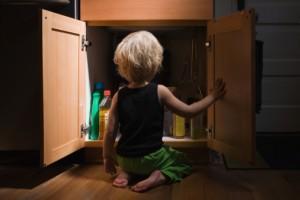March 16 through 22nd was National Poison Prevention week.
Did you know that roughly 2.4 million Americans are poisoned every year, according to the American Academy of Pediatrics, with more than half under the age of six years? In fact, 9 out of 10 poison episodes occur at home.
Safe Kids Worldwide shares the following tips on keeping your home poison proof:
- Keep Cleaners and other toxic products out of reach. Store all household products out of children’s sight and reach. Young kids are often eye-level with items under the kitchen and bathroom sinks. So any bleach, detergents, dishwasher liquid or cleaning solutions that are kept there should find a new storage location.
- Install child safety locks on cabinets where you have stored poisonous items. It only takes a few minutes, and it gives you one less thing to worry about.
- Read product labels to find out what can be hazardous to kids. Dangerous household items include makeup, personal care products, plants, pesticides, lead, art supplies, alcohol and carbon monoxide.
- Don’t leave poisonous products unattended while in use. Many incidents happen when adults are distracted for a moment on the phone or at the door.
- Keep cleaning products in their original containers. Never put a potentially poisonous product in something other than its original container (such as a plastic soda bottle) where it could be mistaken for something else
- Throw away old medicines and other potential poisons. Check your garage, basement and other storage areas for cleaning and work supplies you no longer need and can discard.
- Check your purse for potential hazards. Be aware of any medications or makeup that may be in your handbag. Store handbags out of the reach of young children. Use original, child-resistant packaging
- Buy child-resistant packages when available.
- Keep medicines up and away. Make sure that all medications, including vitamins, are stored out of reach and out of sight or children. Even if you are tempted to keep the medicine handy because you have to give another dose in a few hours, don’t leave it on the counter between dosing. Always put medicines and vitamins away after every use.
- Have Poison Control on Speed Dial!Program the toll-free number for the Poison Control Center (800-222-1222800-222-1222) into your home and cell phone and post it near your phone or on your refrigerator for the babysitter. Hopefully, you’ll never need it, but it’s nice to have just in case. Poison control centers offer fast, free, confidential help in English and Spanish. Most poisonings are resolved over the phone. The number works from anywhere in the United States 24 hours a day, seven days a week.
- If you suspect your child has been poisoned, call poison control. If your child has collapsed or is not breathing, call 911. Do not make the child vomit or give him anything unless directed by a professional.
- Check for Lead. Check homes built before 1978 for lead-based paint. If lead hazards are identified, test your child for lead exposure and hire a professional to control and remove lead sources safely. Remove any peeling paint or chewable surfaces painted with lead-based paint.
- Regularly wash your child’s toys and pacifiers to reduce the risk of your child coming into contact with lead or lead-contaminated dust. Check www.recalls.gov for more info on product recalls involving lead-based products. Follow the recommendations to eliminate any products such as toys or cookware that contain lead.
- Install a Carbon Monoxide Alarm and Identify Signs of Poisoning ! Install a carbon monoxide alarm on every level of your home, especially near sleeping areas, and keep them at least 15 feet away from fuel-burning appliances.
For more information go to www.safekids.org
Call Send SMS Add to Skype You’ll need Skype CreditFree via Skype

